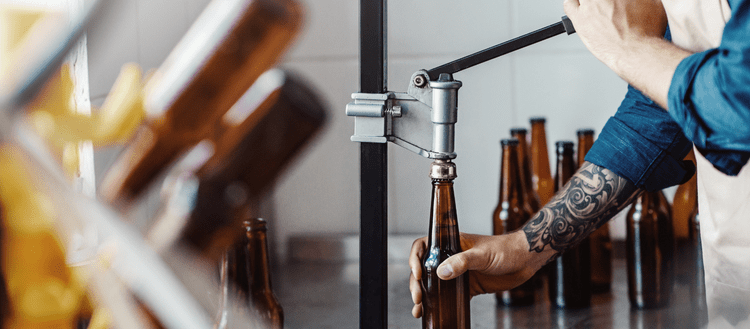These bottles of beer with a cork really stand out on the shelves. They make you wonder about them. As someone who was into wines and then shifted interests towards beer when the craft scene started rising, I can’t help but ask why and what are the benefits of the beer bottles closed with the cork. Especially now, with the rise of craft beer, we’re seeing plenty of 750 mL bottles stopped with a cork enclosure.
Can you bottle beer with a cork?
With the rise of craft beer, we started seeing many more 750ml beer bottles stopped with a cork. So the answer is obvious and simple – Yes, you can bottle beer with a cork. But is it a necessity, or is it just for marketing purposes?
Why should you bottle beer with a cork?
Just like with Champagne, second fermentation happens in the bottle of beers bottled with corks. So, when bottling beer, a small amount of sugar and yeast is added to the liquid (in Champagne, that’s called Liqueur de Tirage, and it’s part of the traditional method of making it), and the second fermentation takes part in the bottle.
Not only that second fermentation brings rich and complex flavors to the beer, but due to yeast eating sugar, it creates high pressure in the bottle. Some strong Belgian beers, like Bierre de Garde or Tripel, can be carbonated with even 3.3+ volumes of CO2. Some Sours and Lambics can go up to 4.5 volumes of CO2.
Due to high carbonation, if caps are used for closure, they can leak if they’re accidentally dislodged, but a cork would prevent a significant amount of CO2 from escaping the bottle. I’ve even seen corks with caps on top, covered with wax ensuring even better closure.
Besides keeping valuable bubbles inside the bottle, bottling beer with cork can help age-worthy beers to age, just like a fine wine slowly releasing a small amount of oxygen.
How to Store Cork-Finished Beer
Talking about aging beer, you’re probably wondering how that age-worthy beer should be stored. There are different opinions on this, some facts are in favour of storing beer with a cork laying down or on the side, and others are in favour of storing the cork-finished beer in the upright position.
Namely, the oxygen exposure rate on cork topped beers is five to six times greater than the exposure of the cap-closed beers. And while oxidation is something that’s desirable for wine, it’s not really necessary for beer. In fact, beer will mature more rapidly.
But suppose we let the oxidation take place at a slow pace, gradually, while controlling the process. In that case, it can mellow hot unruly barleywine and mellow it, making it smoother, and more palatable over the course of three, five, or ten years.
I had my doubts about storing the beer upright for a more extended period of time, too. Still, Even Ray Daniels, director of the Cicerone Certification Program, suggests keeping cork-topped beers upright. I’ve even tried to get a second opinion from the brewer from the local micro craft brewery that confirmed that the best position for storing beer for aging is upright.
The other opinion is that the cork-toped beers should be stored on the side just like wine and unlike strong spirits like Whiskey. Whiskey is not stored in contact with the cork due to its high alcohol volume that would start disintegrating the cork. But that’s not the case with the beer. Some super strong beers are almost as high in ABV as some red wines, not even as high in alcohol as Sherry or Madeira, that have higher alcohol content but are still bottled with cork.
And I even see the whole point in keeping beer on the side, too. Cork is a natural material (made of oak bark), and if it’s not in contact with the liquid, it can dry out, and therefore it can be broken, making opening your cork-toped beer much harder, and you even risk cork crumbling into the beer and spoiling its taste.
Extra tip: Whenever second fermentation occurs in the bottle, there must be sediment, right? You might be worried about that yeast sediment ending up in your glass, but the solution is quite simple. If you’re planning on opening your aged beer for dinner, just take it off the shelf in the afternoon and leave that sediment to rest at the bottom of the bottle until the evening and be super cautious when manipulating the bottle, especially when pouring that last glass.
If you want to take proper care of your beer, don’t keep it in bright places. Instead, it should be kept just like wine – in a dark, cool, and dry place that is not prone to temperature swings.
What does a cork do to alcohol, and can it ruin the taste of beer?
The biggest concerns here are probably alcohol evaporation through the cork and can the taste of beer be ruined by the cork.
Does alcohol evaporate through the cork?
So, to answer the concern of beer evaporating through the cork – it does evaporate. Both water and ethanol molecules evaporate through the cork due to their tiny, unstable size. And the more headspace there is, the more it’s evaporating. But that shouldn’t be a concern. The amount of evaporation is so small that the beer could probably never lose a noticeable amount of alcohol.
You’ve probably noticed that most beers that are closed with cork have higher alcohol content. They’re probably lambic type or imperial versions of some of the main beer styles or similar, and through the process of aging, the tiny amount of alcohol that evaporates can only be beneficial to the beer as it gradually matures it’s flavour, and makes it smoother and softer for the final consumption.
Can the cork impact the taste of beer?
It happens with some stronger spirits that in contact with it the cork, the cork starts dissolving; therefore, the taste of spirit can be ruined. But the beer is not that high in alcohol that can start dissolving the cork.
On the other side, just like wine, beer can get corked too. It can happen due to bacteria called Trichloroanisole (TCA for short), but you would definitely notice the smell of musty cardboard, wet dog, or a moldy basement before you start drinking your beer.
The good news is that TCA doesn’t occur that often anymore. During the 1950s to 1980s, farmers used a group of fungicides and insecticides (commonly named chlorophenols) that produced TCA in contact with the fungi, mold, or certain bacteria of the bark tree. Fungi have a defense mechanism that chemically alters chlorophenols but creates TCA while defending. Given that the cork is a natural material made of that exact bark tree, you could never know if the cork is contaminated.





